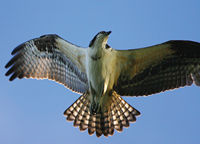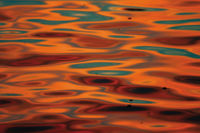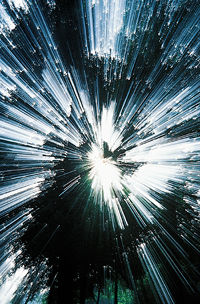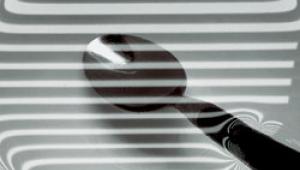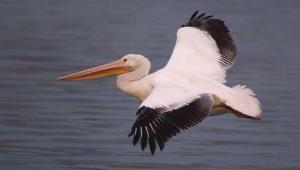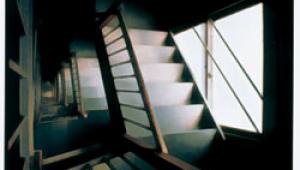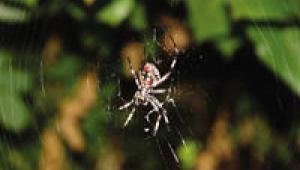The lenses that we use will define the kind of pictures that we are going to accomplish. - BentleyForbes
Choosing and Using Lenses Page 3
|
Wide-Angle Lenses
As their name implies, wide-angle lenses take in a wider angle of view than "normal" lenses do. Wide-angle lenses have shorter focal lengths—for 35mm cameras, from 35mm (which provides a 63° angle of view, compared to 46° for a 50mm "normal" lens) down to 14mm (114° angle of view), with those under 21mm considered "superwides." Digital SLRs with image sensors smaller than a full 24x36mm 35mm film frame "crop in" on the image, and thus a given lens doesn't provide as wide an angle of view as it does on a 35mm film camera, or a digital SLR with a "full-frame" sensor (see the next section)—thus such digital SLRs are not the best choices for photographers specializing in wide-angle work. There are several good reasons to use wide-angle lenses. An obvious one is to get everything in when you can't move far enough away to do it with a longer lens. Another is to record vast scenic vistas. Yet another is to exaggerate the size of a nearby subject by moving in very close to it, while the lens's wide angle of view keeps background subjects in the picture. Do wide-angle lenses "distort" perspective? Only if you move the camera. Focal length alone doesn't change perspective. Perspective is a result of camera position—how far the camera is from the subject. Folks generally move a lot closer when using wide-angle lenses, and it is the close shooting distance that "expands" the perspective—not the short focal length. So, if you want to expand perspective—make close objects appear much larger than more distant ones, and seemingly increase the distance between them—move in close with a wide-angle lens. You'd get the same expansion moving in to the same distance with a longer lens, but its narrower angle of view would include only a small portion of the subject (and it probably couldn't focus that close), so you won't notice the effect. Conversely, if you crop in on the center of a shot made with a wide-angle lens, you'll get a "telephoto compression" effect—only the most distant portion of the scene will be included in the picture, just as if you'd shot from the same spot with a longer lens.
Digital-Camera Angle of View
Long Lenses
The primary purpose for long lenses is to bring distant subjects to you when you can't get to them. Wildlife and sports photographers use long lenses to get those dramatic close-ups. Short telephotos (85–135mm for 35mm cameras) are ideal portrait lenses, because they produce a good head size at a shooting distance that provides pleasing perspective: If you use a shorter lens, you have to move closer to get a good head size, and this expands perspective, resulting in pointy noses and a "warped" look; and if you use a longer lens, you have to move farther away to get a good head size, and moving back compresses perspective, resulting in a "flattened" look. Another good use for really long lenses is to zero in on a subject from a great distance to compress the perspective—those "stacked-up" rush-hour freeway traffic photos are made this way. Long lenses are commonly referred to as "telephotos," but not all long lenses are telephotos. Telephotos utilize a particular optical design in which the lens's physical length is shorter than its focal length: the optical center is actually in front of the lens. Be aware that long lenses magnify camera movement along with the subject, so they're best used on tripods. In fact, longer lenses generally come with built-in tripod mounts. (Because long lenses are heavier than most camera bodies, you actually attach the lens itself to the tripod to avoid stress on the lens mount.) The rule of thumb is to put the camera on a tripod if you can't use a shutter speed at least equal to the reciprocal of the lens' focal length (e.g., at least 1/300 with a 300mm lens), but in practice it's wise to put any lens of 300mm or longer on a tripod whenever possible regardless of shutter speed. Canon and Nikon offer telephotos with built-in image stabilizers that let you get sharper shots hand-held, and these devices really do work, but it's still best to use a tripod when possible (switch off the image stabilizer when the lens is on a tripod). Depth of field is limited with long lenses, a fact that portrait photographers can put to use: Shoot with a short telephoto lens wide open, and you can throw a distracting background totally out of focus, so that attention is concentrated on the subject's face. Pro wildlife and action photographers use fast professional long lenses—the 600mm f/4 is a very popular item with that set. But such lenses are very costly. If you're on a limited budget, you can make do with a slower lens and use faster film. One popular combination is a fast 200mm f/2.8 lens (far less costly than a fast 400mm lens) and a 2X tele-converter, which turns the 200mm f/2.8 into a 400mm f/5.6. Tele-converters fit between the lens and camera body, and increase the focal length by a factor of 1.4X or 2X (there are other magnifications available, too). A 1.4X converter slows the maximum aperture by one stop, a 2X converter by two stops—but you get a focal-length increase of 1.4X or 2X, while retaining the same minimum focusing distance—in effect getting two lenses for less than a fast 400mm lens. The mirror lens, also known as a reflex lens, is a special type of long lens. Mirror lenses provide long focal lengths in short, lightweight packages by "folding" the light back and forth inside the lens barrel. Mirror lenses are much shorter than conventional refracting lenses of equal focal length, have much closer minimum focusing distances, and are generally considerably less costly; but they also are generally not quite as sharp as their refracting counterparts. Most mirror lenses lack a diaphragm (f-stops), so exposure is controlled by adjusting the shutter speed, or by using neutral-density filters (which are built into many mirror lenses). Early mirror lenses were extremely fragile, and the type still requires gentler treatment than other lenses, actually. Most of today's mirror lenses are catadioptric, meaning they contain refracting lens elements as well as mirrors, to produce even more-compact lenses. |
- Log in or register to post comments
